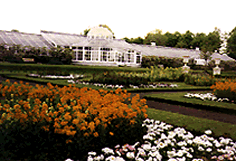Archaeologists unearth historical treasures at Chiswick House Grounds
| Other local events | |
Thousands flock to Community Arts Festival Community Arts Festival at Chiswick House & Grounds Rare opportunity to visit Kitchen Walled Garden If you have a local event you'd like to promote - click here |
|
| Participate | |
Sign up for our free weekly newsletter |
English Heritage archaeologists believe they have found the remains of the 17th century "knot garden," originally laid out behind the stable block of Old Chiswick House, the Jacobean mansion that was demolished in 1788.
This rare survival of a 400 year old garden design was uncovered during excavations that took place at Chiswick House and Gardens over the summer.
Although archaeologists found that the remnants of the garden are fragmentary, and only 10 centimetres deep in places, they have been able to identify two distinct phases of garden bedding. It is likely that the first phase was associated with the Jacobean house, dating to around 1610, with the second design dating from later in the 17th century, and probably associated with the construction of the Stable Block in the 1680s.
Archaeologists were able to confirm that the knot garden could date back as far as 1610 with the discovery of a Nuremberg token. This item, unusual because of its unworn condition, is around the size of a two pence piece, was used as a counter in post-medieval accounting and dates to between 1610-1616.
The excavated evidence corroborates the historic pictorial evidence of an early formal garden, and gives us a glimpse of the garden's layout and design, based around a pattern of linear beds. 17th century knot gardens were often laid out along symmetrical geometric lines, and at their most simple a square garden intersected by paths at right angles could be called a knot.
English Heritage archaeologist Dave Fellows commented, "It is exciting to find the remains of a garden dating back as far as this one. Garden designs continually evolve as fashions change, so in many cases we lose evidence for the earlier lay outs as the new ones are excavated. We have been lucky here because it seems that at some time in the early 18th century the area was landscaped and the original design was buried, with a new garden created at a higher level preserving what was left underneath for us to find."
Records show that the original 17th century knot garden was modified in the early 18th century by Lady Burlington and William Kent to form a garden with a circular pond, fountain and landscaped beds. It was known as Lady Burlington's "flower garden" and the "volerie" (or
aviary) garden. Archaeologists believe the excavations may have also uncovered the footings for the aviary building shown on a 1736 survey of the garden. As simple wooden structures, aviary buildings very rarely survive so it is particularly unusual to find evidence for a structure dating back to the 18th century, in this case because it may have been a more substantial building than was usual.
The knot garden and volerie garden are both to the north of the site of the 17th century Stable Block of Old Chiswick House. In this same area the excavations revealed further exciting evidence for a later garden design in the form of three rectangular flower beds thought to be the remains of the 'Royal Flower Beds' that were named after, and occasionally tended by, Edward VII's children, George, Maud, Albert, Louise and Victoria, during their stays at Chiswick in the late 19th century and early 20th centuries.
In front of the Stable Block site, the archaeologists have uncovered the remains of the gravel carriageway and of the oval central island around which carriages would have turned as they approached the house. The excavation also revealed parts of the Stable Block itself, built, it is thought, in the late 17th century and demolished in the 1930s. The block has often been claimed as the design of the celebrated gentleman architect, Hugh May, who worked for Charles II remodelling the royal apartments at Windsor Castle.
The weather has played its role in revealing Chiswick's secrets as the dry summer has created parch marks on the grass lawns which outline the walls of another 17th century stable block, once part of Moreton Hall, the villa next to the Old Chiswick House. A trench on this part of the site revealed that when in use the building had a roughly pebbled floor surface.
September 29, 2005
